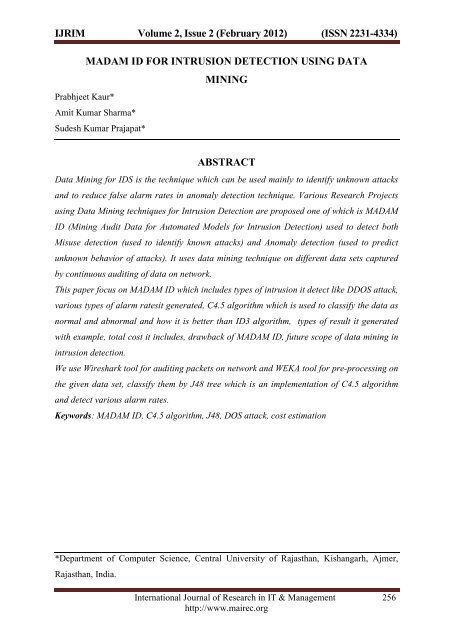madam id for intrusion detection using data mining - Euroasiapub.org
madam id for intrusion detection using data mining - Euroasiapub.org madam id for intrusion detection using data mining - Euroasiapub.org
- Page 5 and 6: IJRIM Volume 2, Issue 2 (February 2
- Page 7 and 8: IJRIM Volume 2, Issue 2 (February 2
IJRIM Volume 2, Issue 2 (February 2012) (ISSN 2231-4334)• It can handle attributes with different costs.Fig 5 shows the decision tree of <strong>data</strong> set given in Fig 1.Fig 5By J48 classifier the <strong>data</strong> set given in Fig 1 can be div<strong>id</strong>ed into various classes and itsaccuracy can be calculated by various parameters. These are• True positive (TP): This alarm corresponds to the numberof detected attacks and it isin fact attack[1].• True negative (TN): This alarm corresponds to the numberof detected normalinstances and it is actually normal [1].• False positive (FP):This alarm corresponds to the number of detected attacks but it isin factnormal [1].• False negative (FN): This alarm corresponds to the numberof detected normalinstances but it is actuallyattack, in other words these attacks are the targetof <strong>intrusion</strong><strong>detection</strong> systems [1].• Precision (A) =number of correctly classified instances of class A / number ofinstances classified as belonging to class A [6].• Recall (A) = number of correctly classified instances of class A/ number of instancesin class A [6].• The true positive rate (TPR) TPR = TP / (TP + FN)• The true negative rate (TNR) = TN / (TN + FP)• False positive rate(FPR)= FP / (TN + FP)• The false negative rate (FNR)= FN / (TP + FN )Table 1 gives the detailed accuracy by class of <strong>data</strong> set given in Fig 1.International Journal of Research in IT & Management 260http://www.mairec.<strong>org</strong>
IJRIM Volume 2, Issue 2 (February 2012) (ISSN 2231-4334)TP Rate FP Precision Recall ClassRate1 0 1 1 Continuationor non-HTTPtraffic1 0.133 0.333 1 49755 > httpAck=28410 0 0 0 49756 > httpAck=28410 0 0 0 49750 > httpAck=11 0.133 0 .333 1 49753 > httpAck=10 0 0 0 49758> httpAck=28410 0 0 0 49756 > httpAck=5681WeightedAvg.0.75 0.017 0.667 0.75TTable 14. MADAM ID FEATURES AND LIMITATIONA. DETECTION OF DDOS ATTACKThe mission of this attack to send unusual traffic towards the victim to make it busy [7, 8].InFig 1 we say that the destination host with 192.168.1.11 IP address have http service requestin the past few seconds. So, there is the possibility of denial of service attack with thatservice.According to this type of analysis we classify the <strong>data</strong> set as normal or abnormal and detectvarious types of <strong>intrusion</strong>s.B. COST EVALUATIONIt can be evaluated by various cost factors. These are• Damage cost: The maximum amount of damage occurs when <strong>intrusion</strong> <strong>detection</strong>system is not available.International Journal of Research in IT & Management 261http://www.mairec.<strong>org</strong>
IJRIM Volume 2, Issue 2 (February 2012) (ISSN 2231-4334)• Response cost: Is the cost to take an action when <strong>intrusion</strong> is found.• Consequential cost: Cost due to connection.For MADAM ID various cost levels features are• At the beginning of an event• At the m<strong>id</strong>dle to end of an event• At multiple events in a time window[9]C. LIMITATION OF MADAM ID• It is applied only at connection level.• Within connection classification of contents are very challenging [9].II. DRAWBACK OF INTRUSION DETECTION SYSTEM BASED ON DATA MINING.• It is very consuming due to massive ef<strong>for</strong>ts in analyzing the <strong>data</strong> and categorizes themaccording to useful and raw <strong>data</strong> that also results in high cost and manpower.• The behavior of the attack changes frequently and thus the <strong>data</strong> used <strong>for</strong> auditing alsowhich requires continuous monitoring of <strong>data</strong> and filtering ef<strong>for</strong>ts to <strong>id</strong>entify them asnormal suspicious [10].5. CONCLUSION AND FUTURE SCOPEThis paper described MADAM ID which used classification technique of <strong>data</strong> <strong>mining</strong> thatimprove theper<strong>for</strong>mance of Intrusion Detection Systems (IDS).Weka tool helps to get theproper understanding of this technique by analyzing on different aspects of given <strong>data</strong> set<strong>using</strong> C4.5 algorithm. Experimental result shows how to <strong>id</strong>entify DDOS attack most commontype of <strong>intrusion</strong> violating security.Future work will include payingmore attention to prov<strong>id</strong>ebetter methods ofproper auditing the <strong>data</strong> which is most difficult task and classify themefficiently. To work on projects which are basis of <strong>detection</strong> of unknown behavior of attackwhich greatly affect the security of various systems.REFERENCES[1] Mohammadreza Ektefa, Sara Memar, Fatimah S<strong>id</strong>i and Lilly Suriani Affendey,”IntrusionDetection Using Data Mining Techniques”,978-1-4244-5651-2/10/$26.00 ,2010 IEEEC. Xiang, M. Y. Chong and H. L. Zhu” Design of Multiple-Level Tree Classifiers<strong>for</strong>Intrusion Detection System”, Proceedings of the 2004 IEEEConference on Cyberneticsand Intelligent SystemsSingapore, 1-3 December, 2004[2] C. Xiang and S. M. Lim,”Design Of Multiple-Level Hybr<strong>id</strong> Classifier ForIntrusionDetection System”,0-7803-9518-2/05/$20.00,2005 IEEE[3] Jiawei Han and Micheline Kamber, Data Mining Concepts and Techniques, 2ndEd.International Journal of Research in IT & Management 262http://www.mairec.<strong>org</strong>
IJRIM Volume 2, Issue 2 (February 2012) (ISSN 2231-4334)[4] J.R.Quinlan. C4.5: Programs <strong>for</strong> machine learning. M<strong>org</strong>an Kaufman Publishers, 1993.[5] P Srinivasulu1, D Nagaraju, P Ramesh Kumar, and K Nageswara Rao,” Classifying theNetwork Intrusion Attacks<strong>using</strong> Data Mining Classification Methods and theirPer<strong>for</strong>mance Comparison”IJCSNS International Journal of Computer Science andNetwork Security, VOL.9 No.6, June 2009[6] Kanwal Garg and Rshma Chawla,”Detection Of DDOS Attack Using DataMining”,(IJCBR)ISSN (Online) : 2229-6166, Volume 2 Issue 1, 2011[7] Yoohwan Kim, Wing Cheong Lau, Mooi Choo Chuah And Jonathan H.Chao“Packetscore: Statistical-Based Overload Control Against Distributed Denial-Of-Service Attacks” IEEE INFOCOM 2004 ,The 23rd Annual Joint Conference of the IEEEComputer and Communications Societies, Hong Kong, China, March 7-11, 2004. IEEE,2004.[8] AleksandarLazarević, Ja<strong>id</strong>eep Srivastava and VipinKumar, “Data Mining For IntrusionDetection”, ArmyHigh Per<strong>for</strong>mance Computing Research Center Department ofComputer Science University of Minnesota, Tutorial on the Pacific-Asia Conference onKnowledge Discovery in Databases 2003[9] Anoop Singhal and Sushil Jajodia, “Data wareho<strong>using</strong> and <strong>data</strong> <strong>mining</strong> techniques <strong>for</strong><strong>intrusion</strong> <strong>detection</strong> systems”, Distrib Parallel Databases (2006) 20:149–166, SpringerScience+Business Media, LLC 2006.International Journal of Research in IT & Management 263http://www.mairec.<strong>org</strong>



